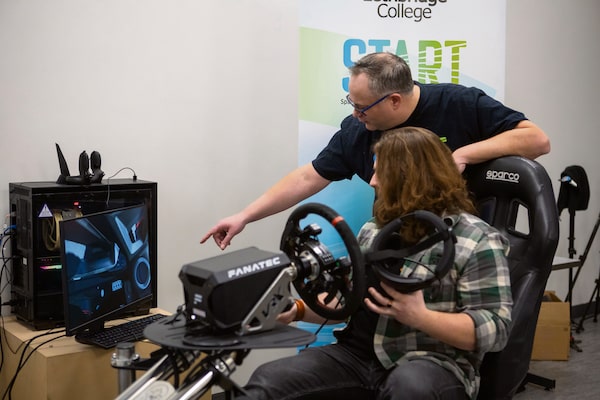
At Lethbridge College, Mike McCready and Austin Hatch are part of the team working with a prototype research model (pictured) that will assist in the development of the final VR driving simulator.SUPPLIED
While many old-timers may have fond memories of whiling away time playing Pong on green-screen computer monitors back in the early ‘70s, video games have come a long way since then. Virtual reality (VR) is now the must-have technology for any serious gamer.
But while VR has taken gaming to a level that existed only in science fiction 50 years ago, the technology has far wider applications than just entertainment. For example, researchers at Lethbridge College in southern Alberta are developing VR solutions to meet real-world challenges faced by a range of key sectors in the province, including agriculture, energy, architecture, health care, cultural heritage and emergency response.
The college’s Spatial Technologies Applied Research and Training (START) centre is working on VR and AR (augmented reality) applications to help business and the public sector save money, enhance collaboration and improve safety.
(Unlike VR, which creates a completely artificial environment, AR overlays – or eliminates – images and information in a real-world environment, usually through a user’s hand-held device or special glasses.)
One of START’s current projects is a program to use VR to help train police officers in safe driving techniques when responding to situations such as high-speed travel to emergency calls.
Mike McCready, industry liaison and research advisor with START, and instructor in the college’s VR and AR certificate program, says one of the best uses of VR training modules is to simulate situations in a virtual 3-D environment that may be very dangerous in the real world.
“For example, police officers do driver training on a closed track where they practise manoeuvres, braking, turning and so on, but they can’t practise decision-making effectively – what to do if another driver runs a red light in front of them, or a pedestrian steps into the street while they are speeding to an emergency,” says Mr. McCready.” These types of situations are simply too dangerous to practise in the real world, but they can be simulated in VR in a way that gives the officer the opportunity to learn the right response.”
The internet allows us to connect, communicate, do business and have fun. VR and AR are allowing us to do similar things but in a three-dimensional way.
— Mike McCready, Industry Liaison and Research Advisor, Lethbridge College Spatial Technologies Applied Research and Training (START) centre
Similarly, VR can be used to help train big rig drivers before they get out onto the road. It could also be used to simulate maintenance or repairs in high-risk industrial plants to help technicians understand what they need to do before they are faced with an actual breakdown or maintenance need.
VR’s application outside of video games is not confined to training for dangerous situations. It can also be an important educational tool, says Mr. McCready, noting that the Lethbridge team created a VR experience for visitors to the world-famous Grand Cache dinosaur track site, which allows them to interact with the site and become paleontologists for a day.
“VR and AR technology is really just an evolution of what we see on the internet today,” says Mr. McCready. “The internet allows us to connect, communicate, do business and have fun. VR and AR are allowing us to do similar things but in a three-dimensional way.”
He notes that there are several studies showing how virtuality can change perceptions on issues ranging from views of a particular population to topics like global warming or water pollution.
“It really is a powerful tool to connect us, but also to help inform and shape people’s opinions,” he adds.
Austin Hatch, a graduate of Lethbridge’s VR program, is currently working on a one-year NSERC-funded internship with START. After completing a two-year Multimedia Production diploma program at the college, he was considering his next move and decided on the VR program.
“After going through the program and being steeped in the technology for about a year, it definitely seems to be a great step forward in training people for different job scenarios,” says Mr. Hatch.
His role as an intern is essentially that of a junior developer applying what he learned in the VR course to the development of START’s projects.
He jokes that START is like a playground for developers: “We get to play with all the new toys and do research-driven development, just trying to see how far we can push this and make it work.”
Advertising feature produced by Randall Anthony Communications with Colleges and Institutes Canada. The Globe’s editorial department was not involved.